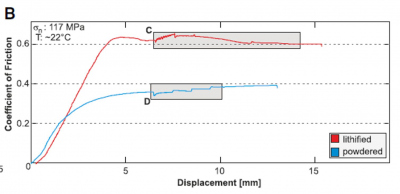HYDSPA
The HYDSPA system is capable of normal stresses of up to 200 MPa and temperatures of up to 240°C, simulating depths of ~10-15 km in the Earth’s crust This apparatus consists of a sturdy load frame, two powerful low-friction hydraulic pistons (one vertical, one horizontal), and an external heating chamber which houses the sample cell. The design of the device and sample holder are similar to that of the Giesa devices. The holder is fitted into a heavy-duty roller gear device capable of moving effective loads of several tons at almost negligible friction. Within the sample cell, an O-ring seal to confines the pore fluid on the sample surface. Three ports installed in the lower half allow pore pressure measurement; one port accesses the bottom of the sample and is designed to record fluid pressure rise during (vertical, or normal) loading, i.e. the backpressure. Another port monitors fluid pressure on the actual shear surface, and is isolated from the other fluid ports and areas of the sample chamber. The apparatus is currently configured for pore pressure monitoring without control, although the maximum pore pressure can be limited by manually venting the pore fluid. Temperature is permanently monitored via a fourth access port and is instrumented with a thermistor. In its present state, this device is capable of producing excellent friction data using conventional velocity-stepping procedures within the velocity range of 0.1-100 µm/s (10-7-10-4 m/s) (Trütner et al., 2015), which is comparable with most established friction data produced over the last ~20 years. Therefore, relevant friction data sheared at a plate-rate boundary condition may be collected at conditions appropriate for well within the seismogenic zone (corresponding to approximately 10-15 km, depending on assumed P-T gradients).



